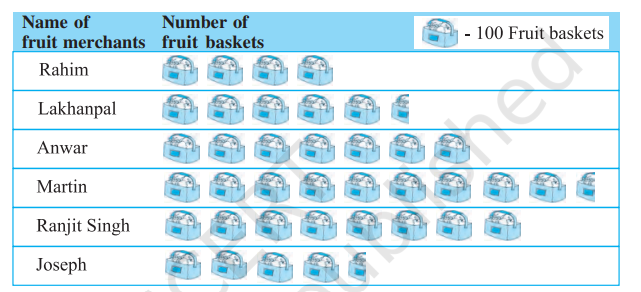In a survey, 200 students were asked what influenced them most to buy their latest CD. The results are shown in the circle graph. ,
(a) How many students said radio influenced them most?
(b) How many more students were influenced by radio than by a music video channel?
(c) How many said a friend or relative influenced them or they heard the CD in a shop?

Step by step video & image solution for In a survey, 200 students were asked what influenced them most to buy their latest CD. The results are shown in the circle graph. , (a) How many students said radio influenced them most? (b) How many more students were influenced by radio than by a music video channel? (c) How many said a friend or relative influenced them or they heard the CD in a shop? by Maths experts to help you in doubts & scoring excellent marks in Class 7 exams.
Updated on:21/07/2023Topper's Solved these Questions
- FRACTIONS AND DECIMALSBOOK - NCERT EXEMPLARCHAPTER - FRACTIONS AND DECIMALSEXERCISE - EXERCISE (FIND THE ERROR)
3 Videos
- FRACTIONS AND DECIMALSBOOK - NCERT EXEMPLARCHAPTER - FRACTIONS AND DECIMALSEXERCISE - THINK AND DISCUSS
9 Videos
- EXPONENTS AND POWERSBOOK - NCERT EXEMPLARCHAPTER - EXPONENTS AND POWERSEXERCISE - EXERCISE
136 Videos
- INTEGERSBOOK - NCERT EXEMPLARCHAPTER - INTEGERSEXERCISE - VOCOBULARY
5 Videos
Similar Questions
A survey was carried out by the principal of a school to find the favourite subject of middle school students. The results of the survey is shown in the pictograph.

How many more students like English than Science?
View SolutionStudy then following bar graph carefully and answer the questions.

In1990,how many more students were enrolled at state university than at Central University
View SolutionIn a Mathematics test, the following marks were obtained by 40 students. Arrange these marks in a table using tally marks.(a) Find how many students obtained marks equal to or more than 7.(b) How many students obtained marks below 4?
View SolutionAnswer the following :
(a) How many types of fission are possible of a covalent bond?
(b) how many types of ions are formed by heterolytic fission and what are their names?
(c) What are the names and nature of the parts formed by homolytic fission?
(d) How many electrons are present in the valence shell of the carbon atom of the carbonium ion?
(e) How many electrons are present in the valence shell of carbon atom of the carbanion ion?
(f) Name the attacking reagents and give their nature.
(g) Write the names of the parts obtained when C−Cl bond of ethyl chloride undergoes heterolytic fission.
(h) What is the major factor that influences the relatives stabilities of carbocations, carbanions and free radicals.
View SolutionSimranjit studies in tenth class in a school. There are fifty students in his class. Most of the students come to the school by separate cars driven by their parents and also go back by separate cars. One day their science teacher was teaching the chapter on sources of energy. He told the students that the fossil fuels are limited in nature and we should make efforts to conserve them by reducing their consumption. Hearing this, an idea came to Simranjit's mind which he shared with the three classmates who live in the same area. All these students liked the idea. These students talked to their parents, and even the idea mooted by Simranjit ?
(a) What could be the idea mooted by Simranjit ?
(b) Why was this idea mooted ?
(c) How did this idea help the environment ?
(d) How did this idea help the individual parents ?
(e) What values are displayed by Simranjit in mooting this idea ?
View SolutionThe adjoining pie chart gives the marks scored in an examination by a student in Hindi, English, Mathematics, Social Science and Science.
If the total marks obtained by the students were 540, answer the following questions.
(i)In which subject did the student score 105 marks?
(Hint: for 540 marks, the central angle =360∘. So, for 105 marks, what is the central angle?)
(ii) How many more marks were obtained by the student in Mathematics than in Hindi?
(iii)Examine whether the sum of the marks obtained in Social Science and Mathematics is more than that in Science and Hindi (Hint: Just study the central angles).
View SolutionIn a village six fruit merchants sold the following number of fruit baskets in a particularseason :Observe this pictograph and answer the following questions :(a) Which merchant sold the maximum number of baskets?(b) How many fruit baskets were sold by Anwar?(c) The merchants who have sold 600 or more number of baskets are planning to buya godown for the next season. Can you name them?

View SolutionRead the passage given below and answer the questions that follow.
Screaming is exhibited by many animals, but no species uses this extreme vocalization in as many different contexts as humans. Though we're pretty good at recognizing a scream when we hear one, the wide variety of screams makes it difficult to pin down what defines them.
To study screams is to probe the fuzzy boundary that separates humans from the rest of the animal kingdom. It is a way to explore our pre-linguistic past. Although we are fully symbolic creatures today, on occasion a trace of our primal selves bubbles to the surface in the form of a scream. Understanding its characteristics could improve the treatment of nonverbal patients, help fight crime, or simply make movies more frightening. But first scientists need to explain what makes a scream a scream.
To that end, researchers at Emory University’s Bioacoustics Laboratory recruited 181 volunteers to listen to short recordings of 75 nonverbal human vocalizations, such as screams, laughter, and crying. For each of the 75 sounds, the volunteers were asked to indicate whether they thought it was a scream. The researchers then analyzed 28 acoustic signatures of the sounds, such as pitch, frequency, and timbre, to determine which parameters influence the perception of a sound as a scream.
Most people would say that the defining characteristic of a scream is that it is a focused loud and highpitched, but previous scream research suggests otherwise. In 2015, David Poeppel, a neuroscientist at New York University and the Max Planck Institute, led a study to determine the acoustic qualities that differentiate fearful screams from other nonverbal vocalizations. To do this, Poeppel and his colleagues compiled a corpus of screams lifted from YouTube videos and ones recorded in their lab, then asked volunteers to rank them according to how alarming the sound was. Poeppel also imaged the brains of his volunteers as they listened to screams to see how these sounds affected neural activity.
Why is it difficult to pin down what defines a scream.
View SolutionRead the passage given below and answer the questions that follow.
Screaming is exhibited by many animals, but no species uses this extreme vocalization in as many different contexts as humans. Though we're pretty good at recognizing a scream when we hear one, the wide variety of screams makes it difficult to pin down what defines them.
To study screams is to probe the fuzzy boundary that separates humans from the rest of the animal kingdom. It is a way to explore our pre-linguistic past. Although we are fully symbolic creatures today, on occasion a trace of our primal selves bubbles to the surface in the form of a scream. Understanding its characteristics could improve the treatment of nonverbal patients, help fight crime, or simply make movies more frightening. But first scientists need to explain what makes a scream a scream.
To that end, researchers at Emory University’s Bioacoustics Laboratory recruited 181 volunteers to listen to short recordings of 75 nonverbal human vocalizations, such as screams, laughter, and crying. For each of the 75 sounds, the volunteers were asked to indicate whether they thought it was a scream. The researchers then analyzed 28 acoustic signatures of the sounds, such as pitch, frequency, and timbre, to determine which parameters influence the perception of a sound as a scream.
Most people would say that the defining characteristic of a scream is that it is a focused loud and highpitched, but previous scream research suggests otherwise. In 2015, David Poeppel, a neuroscientist at New York University and the Max Planck Institute, led a study to determine the acoustic qualities that differentiate fearful screams from other nonverbal vocalizations. To do this, Poeppel and his colleagues compiled a corpus of screams lifted from YouTube videos and ones recorded in their lab, then asked volunteers to rank them according to how alarming the sound was. Poeppel also imaged the brains of his volunteers as they listened to screams to see how these sounds affected neural activity.
What was the aim of David Poeppel's study?
View SolutionRead the passage given below and answer the questions that follow.
Screaming is exhibited by many animals, but no species uses this extreme vocalization in as many different contexts as humans. Though we're pretty good at recognizing a scream when we hear one, the wide variety of screams makes it difficult to pin down what defines them.
To study screams is to probe the fuzzy boundary that separates humans from the rest of the animal kingdom. It is a way to explore our pre-linguistic past. Although we are fully symbolic creatures today, on occasion a trace of our primal selves bubbles to the surface in the form of a scream. Understanding its characteristics could improve the treatment of nonverbal patients, help fight crime, or simply make movies more frightening. But first scientists need to explain what makes a scream a scream.
To that end, researchers at Emory University’s Bioacoustics Laboratory recruited 181 volunteers to listen to short recordings of 75 nonverbal human vocalizations, such as screams, laughter, and crying. For each of the 75 sounds, the volunteers were asked to indicate whether they thought it was a scream. The researchers then analyzed 28 acoustic signatures of the sounds, such as pitch, frequency, and timbre, to determine which parameters influence the perception of a sound as a scream.
Most people would say that the defining characteristic of a scream is that it is a focused loud and highpitched, but previous scream research suggests otherwise. In 2015, David Poeppel, a neuroscientist at New York University and the Max Planck Institute, led a study to determine the acoustic qualities that differentiate fearful screams from other nonverbal vocalizations. To do this, Poeppel and his colleagues compiled a corpus of screams lifted from YouTube videos and ones recorded in their lab, then asked volunteers to rank them according to how alarming the sound was. Poeppel also imaged the brains of his volunteers as they listened to screams to see how these sounds affected neural activity.
Choose the correct synonym of the word 'focused' highlighted in the passage.
View Solution
